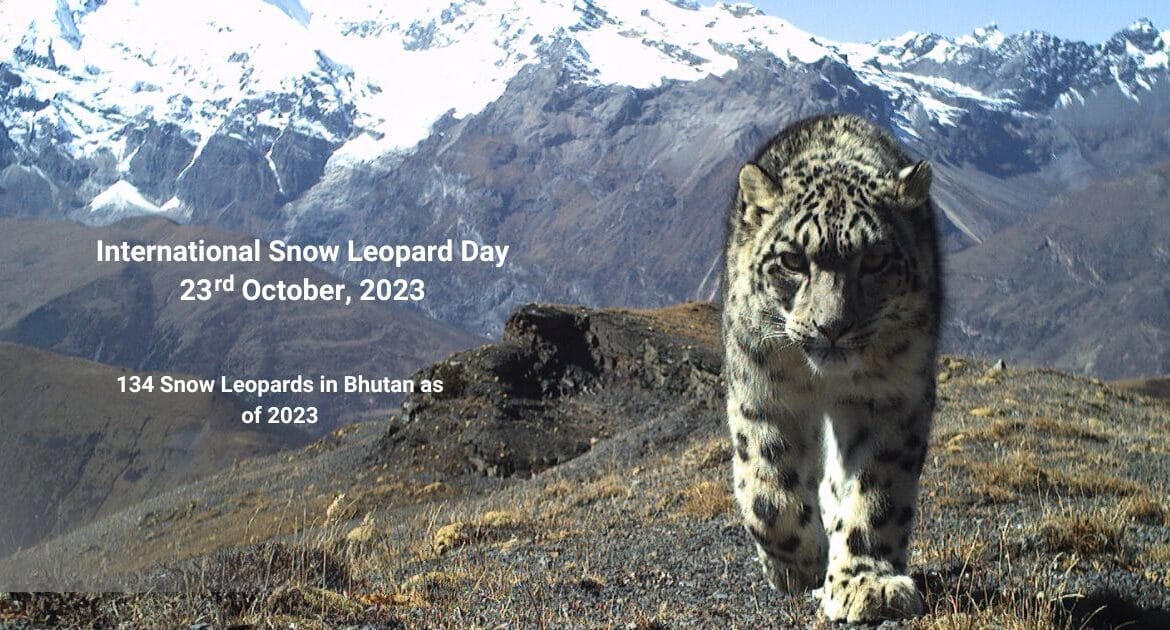National Snow Leopard Survey Report (NSLS) 2022-2023
Background
Snow leopard (Panthera uncia) is one of the apex predator of the alpine region, globally threatened due to habitat loss and fragmentation, prey depletion, human-wildlife conflict due to livestock predation, illegal poaching, impact of climate change and anthropogenic disturbances. The global snow leopard population size is estimated to be between 3,920 to 7,500 individuals, with approximately 2,710 to 3,386 of them being adults (McCarthy and Chapron 2003; Janecka et al. 2008; Snow Leopard Secretariat, 2013; McCarthy et al, 2017). The global population is expected to decrease by at least 10% over 3 generations (22.62 years), leading to the classification of the species as ‘vulnerable’ on the IUCN Red List of Threatened Species.


Snow Leopard Count
In 2016, Bhutan conducted a survey of its snow leopard population, estimating it to consist of approximately 96 individuals. According to the NSLS report conducted from 2022-2023, the population has increased to 134 individuals. This reaffirms Bhutan’s status as a crucial conservation stronghold for snow leopard in the Eastern Himalayas. The survey also revealed that snow leopard density is higher in the western region compared to the central and eastern regions of Bhutan, suggesting a strong likelihood for population connectivity.
Instruments used for survey
During the study, 310 Reconyx® camera traps were deployed in a mode featuring medium-high passive infrared (PIR) sensitivity. These cameras were set to capture 5 photos per trigger, activated by the detection of body heat as the animal passed in front of the sensor. Scat collection was done during installation, monitoring and retrieving of camera trap for non-invasive genetic analysis.
Area Covered
Snow leopards are found in the alpine mountains of Northern Bhutan and the NSLS 2022-2023 encompassed approximately 10,000 km2 focusing primarily on potential snow leopard habitats within the protected areas JKSNR, JDNP, WCNP, and BWS. Amongst the forest division, survey was conducted in potential snow leopard habitats of DFO Paro and Thimphu. These results indicate that Western Bhutan has higher habitat suitability as compared to north-central and eastern Bhutan.
Takeaway
Introduction of Community-based wildlife tourism in areas with high snow leopard density in an opportunity (NSLS, 2022-2023).
Interesting facts
Snow Leopard (Panthera uncia) is renowned for its mysterious nature and remarkable ability to blend into its surrounding (Hunter and Jackson, 1997). Among mountain communities and yak herders, it is revered as Mountain Deity (NCD,2019). As part of Bhutan’s conservation efforts outlined in Milestone 7 of Bhutan for Life Program, the country aims to maintain a stable population of snow leopard by Year 2024 (BFL 2015). To achieve this national goal and to contribute to the global initiative of assessing snow leopard populations, the NSLS 2022-2023 survey was conducted.
Timeline of Snow leopard surveys in Bhutan
1980s: First Leopard Survey was initiated using sign and anecdotal information
1997-2000: Snow Leopard Information Management System (SLIMS) training was delivered
2012: Snow Leopard-focused camera trap was conducted in JDNP
2014: Snow Leopard-focused camera trap was conducted in WCNP
2015 to 2016: Nationwide Snow Leopard using both sign survey and camera traps
2016: 96 individual of Snow Leopard based on spatial camera capture method
2021: Using 2016 survey as a baseline, potential snow leopard suitability mapping was done
2023: 134 individual Snow Leopard based on non-invasive camera trap method with 310 cameras

